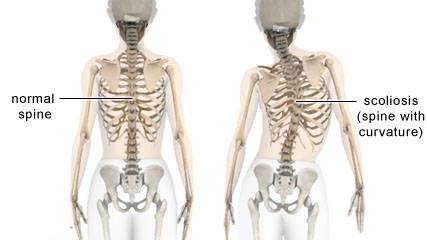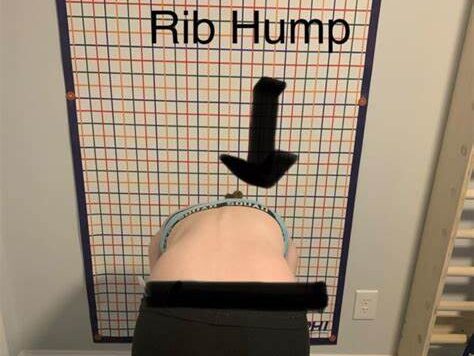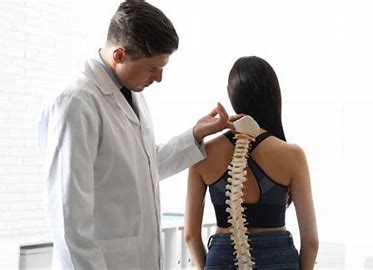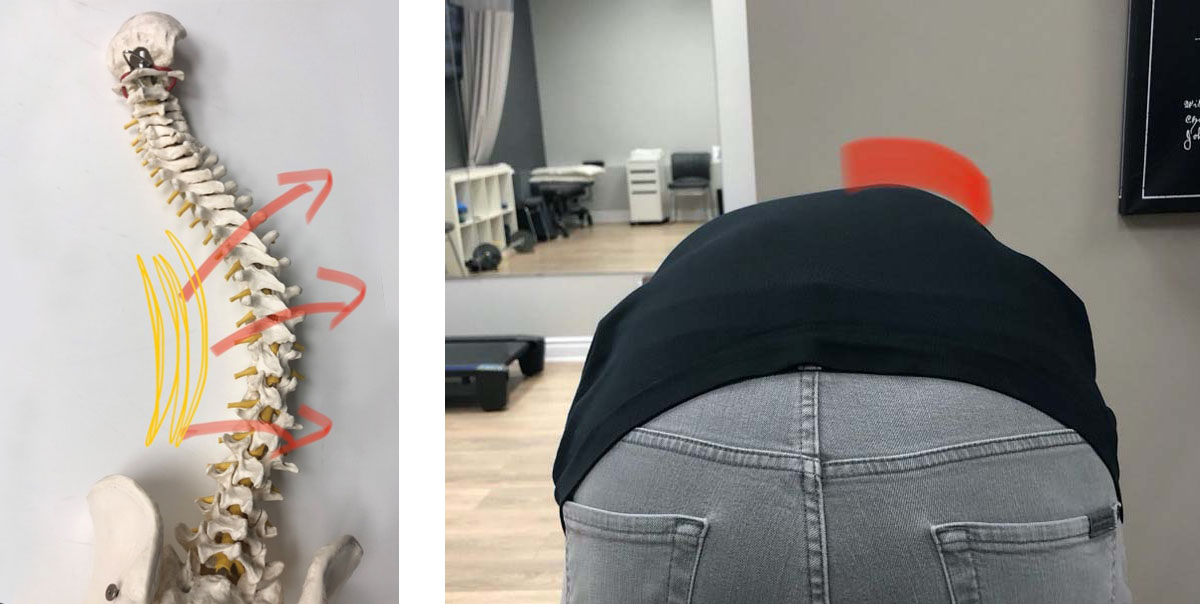Scoliosis is a condition characterized by an abnormal curvature of the spine, which can lead to various physical deformities and imbalances. One common manifestation of scoliosis is the development of a rib hump, also known as a rotational deformity. This article aims to provide a comprehensive guide to understanding and addressing rib hump in scoliosis through effective exercises and lifestyle changes.

What is Scoliosis Rib Hump?
Scoliosis rib hump refers to the visible protrusion of one side of the rib cage, resulting from the rotational deformity of the spine. As the spine curves sideways, the ribs attached to it also rotate, causing one side of the rib cage to appear more prominent than the other. This can lead to physical discomfort, self-consciousness, and postural imbalances.

Understanding the Causes of Rib Hump in Scoliosis
The primary cause of rib hump in scoliosis is the abnormal curvature of the spine. When the spine curves sideways, the vertebrae rotate, causing the ribs to twist and protrude on one side. The severity of the rib hump depends on the degree of spinal curvature and the individual’s specific scoliotic pattern. It is important to note that not all individuals with scoliosis will develop a rib hump, as it varies from case to case.
Importance of Addressing Rib Hump in Scoliosis
Addressing rib hump in scoliosis is crucial for several reasons. Firstly, the rib hump can cause physical discomfort, such as muscle imbalances, back pain, and restricted range of motion. Secondly, it can affect an individual’s self-esteem and body image, leading to decreased confidence and social withdrawal. Lastly, if left unaddressed, the rib hump can worsen over time, potentially leading to further postural imbalances and complications.
Consultation with a Healthcare Professional
Before starting any exercise program to address rib hump in scoliosis, it is essential to consult with a healthcare professional, such as a physical therapist or a certified scoliosis specialist. They can assess the severity of the rib hump, evaluate the individual’s scoliotic pattern, and provide personalized guidance and recommendations. A healthcare professional can also monitor progress and make necessary adjustments to the exercise program.

Precautions and Safety Measures
When performing exercises to address rib hump in scoliosis, it is important to take certain precautions and safety measures. Individuals with scoliosis should avoid high-impact activities that may exacerbate the condition or cause injury. It is also crucial to listen to the body and not push beyond one’s limits. If any exercise causes pain or discomfort, it should be modified or discontinued. Additionally, proper form and technique should be maintained throughout the exercises to ensure effectiveness and prevent injury.
Stretching Exercises for Rib Hump in Scoliosis
Stretching exercises play a vital role in addressing rib hump in scoliosis. These exercises aim to lengthen the muscles on the concave side of the rib hump, promoting better alignment and reducing the prominence of the deformity. Examples of stretching exercises include side stretches, thoracic rotations, and shoulder stretches. These exercises should be performed gently and gradually, focusing on maintaining proper alignment and breathing deeply.
Strengthening Exercises for Rib Hump in Scoliosis
Strengthening exercises are essential for improving muscle imbalances and promoting better postural alignment. These exercises target the muscles on the convex side of the rib hump, aiming to strengthen and stabilize the spine. Examples of strengthening exercises include core exercises, back extensions, and scapular stabilization exercises. It is important to perform these exercises with proper form and control, focusing on engaging the targeted muscles.
Postural Correction Techniques
In addition to stretching and strengthening exercises, postural correction techniques are crucial for addressing rib hump in scoliosis. These techniques focus on improving overall posture and alignment, reducing the prominence of the rib hump. Examples of postural correction techniques include shoulder blade squeezes, chin tucks, and pelvic tilts. These techniques should be incorporated into daily activities and maintained consistently to achieve optimal results.
Incorporating Yoga and Pilates for Rib Hump Improvement
Yoga and Pilates can be beneficial for individuals with scoliosis and rib hump. These practices emphasize body awareness, flexibility, and core strength, which are essential for addressing the deformity. Specific yoga poses and Pilates exercises can target the muscles involved in scoliosis and promote better alignment. It is important to work with a qualified instructor who has experience in working with individuals with scoliosis to ensure safety and effectiveness.
Using Props and Equipment for Rib Hump Exercises
Props and equipment can enhance the effectiveness of rib hump exercises in scoliosis. For example, using a foam roller or a yoga block can provide support and assistance during stretching and strengthening exercises. Additionally, resistance bands or weights can be incorporated to increase the intensity of the exercises. It is important to use props and equipment under the guidance of a healthcare professional to ensure proper usage and prevent injury.
Lifestyle Changes to Support Rib
rib hump, aiming to strengthen and stabilize the spine. Examples of strengthening exercises include core exercises, back extensions, and scapular stabilization exercises. It is important to perform these exercises with proper form and control, focusing on engaging the targeted muscles.
Postural Correction Techniques
In addition to stretching and strengthening exercises, postural correction techniques are crucial for addressing rib hump in scoliosis. These techniques focus on improving overall posture and alignment, reducing the prominence of the rib hump. Examples of postural correction techniques include shoulder blade squeezes, chin tucks, and pelvic tilts. These techniques should be incorporated into daily activities and maintained consistently to achieve optimal results.
Incorporating Yoga and Pilates for Rib Hump Improvement
Yoga and Pilates can be beneficial for individuals with scoliosis and rib hump. These practices emphasize body awareness, flexibility, and core strength, which are essential for addressing the deformity. Specific yoga poses and Pilates exercises can target the muscles involved in scoliosis and promote better alignment. It is important to work with a qualified instructor who has experience in working with individuals with scoliosis to ensure safety and effectiveness.
Using Props and Equipment for Rib Hump Exercises
Props and equipment can enhance the effectiveness of rib hump exercises in scoliosis. For example, using a foam roller or a yoga block can provide support and assistance during stretching and strengthening exercises. Additionally, resistance bands or weights can be incorporated to increase the intensity of the exercises. It is important to use props and equipment under the guidance of a healthcare professional to ensure proper usage and prevent injury.
Lifestyle Changes to Support Rib Hump Improvement
In addition to exercises, certain lifestyle changes can support the improvement of rib hump in scoliosis. Maintaining a healthy diet and weight can reduce the strain on the spine and promote overall well-being. Engaging in regular physical activity, such as swimming or walking, can also help improve posture and muscle strength. Additionally, practicing good ergonomics and avoiding prolonged sitting or standing can alleviate stress on the spine.
Monitoring Progress and Seeking Further Assistance
Monitoring progress is essential when addressing rib hump in scoliosis. Regularly assessing the prominence of the rib hump, range of motion, and overall comfort can help track improvements and make necessary adjustments to the exercise program. If progress is not being made or if the rib hump worsens, it is important to seek further assistance from a healthcare professional. They can provide additional guidance, recommend alternative exercises, or explore other treatment options if necessary.
Conclusion
Addressing rib hump in scoliosis through effective exercises and lifestyle changes is crucial for improving physical comfort, self-esteem, and overall well-being. By understanding the causes of rib hump, consulting with a healthcare professional, and incorporating stretching, strengthening, and postural correction exercises, individuals with scoliosis can work towards reducing the prominence of the deformity. Additionally, incorporating yoga, Pilates, props, and equipment, as well as making lifestyle changes, can further support the improvement of rib hump. By monitoring progress and seeking further assistance when needed, individuals can achieve better alignment, reduced discomfort, and improved quality of life.
References
- Negrini S, Minozzi S, Tontodonati M, et al. “Brace treatment for idiopathic scoliosis in adolescents.” Cochrane Database Syst Rev. 2015;2015(4). https://doi.org/10.1002/14651858.CD003298.pub3
- Weinstein SL, Dolan LA, Cheng JC, et al. “Adolescent idiopathic scoliosis.” Lancet. 2008;371(9623):1527-1537. https://doi.org/10.1016/S0140-6736(08)60658-3
- Negrini S, Donzelli S, Aulisa AG, et al. “2016 SOSORT guidelines: Orthopaedic and rehabilitation treatment of idiopathic scoliosis during growth.” Scoliosis and Spinal Disorders. 2018;13:3. https://doi.org/10.1186/s13013-018-0175-8
- Trobisch P, Suess O, Schwab F. “Idiopathic scoliosis.” Dtsch Arztebl Int. 2010;107(49):875-883. https://doi.org/10.3238/arztebl.2010.0875
- Hresko MT. “Clinical practice. Idiopathic scoliosis in adolescents.” N Engl J Med. 2013;368(9):834-841. https://doi.org/10.1056/NEJMcp1209063
- Bettany-Saltikov J, Weiss HR, Chockalingam N, et al. “Surgical versus non-surgical interventions in people with adolescent idiopathic scoliosis.” Cochrane Database Syst Rev. 2015;2015(4). https://doi.org/10.1002/14651858.CD010663.pub2
- Lonstein JE, Carlson JM. “The prediction of curve progression in untreated idiopathic scoliosis during growth.” J Bone Joint Surg Am. 1984;66(7):1061-1071. https://doi.org/10.2106/00004623-198466070-00008
- Kaspiris A, Grivas TB, Weiss HR, Turnbull D. “Scoliosis: Review of diagnosis and treatment.” International Journal of Orthopaedics. 2013;37(1):34-42. https://doi.org/10.1038/s41390-020-1047-9
- Monticone M, Ambrosini E, Cazzaniga D, et al. “Active self-correction and task-oriented exercises reduce spinal deformity and improve quality of life in subjects with mild adolescent idiopathic scoliosis: Results of a randomized controlled trial.” Eur Spine J. 2016;25(10):3118-3127. https://doi.org/10.1007/s00586-016-4625-4
- Kotwicki T, Negrini S, Grivas TB, et al. “Methodology of evaluation of scoliosis, back deformities and posture.” Scoliosis. 2009;4:26. https://doi.org/10.1186/1748-7161-4-26
- Weiss HR, Suckfüll M, Schreiber S. “Effectiveness of bracing in adolescent idiopathic scoliosis: A systematic review.” Scoliosis. 2013;8:2. https://doi.org/10.1186/1748-7161-8-2
- Cummings JL, Clark J. “Management of adolescent idiopathic scoliosis: A review of recent advances.” Curr Orthop Pract. 2015;26(2):133-138. https://doi.org/10.1097/BCO.0000000000000184
- Lehnert-Schroth C. “Scoliosis: Diagnosis and conservative treatment.” Springer-Verlag Berlin Heidelberg. 2007. https://link.springer.com/book/10.1007/978-3-540-69462-3
- Wáng Y, Xu L, Li Y, et al. “The effect of scoliosis on the rib cage: A radiographic study.” Spine J. 2016;16(8):930-936. https://doi.org/10.1016/j.spinee.2016.04.015
- Hsu LC, Hsu CC, Hsu LL. “Rehabilitation for scoliosis patients: A systematic review.” Disabil Rehabil. 2017;39(24):2471-2481. https://doi.org/10.1080/09638288.2016.1211562

